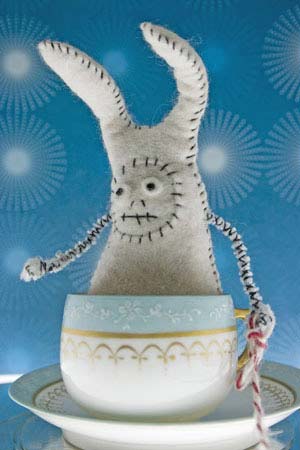Christian Pitt's art fits somewhere between the seventh-grade world of Dawn Wiener in the 1996 film Welcome to the Dollhouse and the parlor life of Nora Helmer in Henrik Ibsen's 1879 play A Doll's House.
The dollhouse family and creature-cute monsters of
Pitt's photos and miniature dioramas are the stuff an adolescent like
Dawn Wiener might be trying to wean herself from. They are narcotic
play-pretties for an awkward girl edging her way into the realm of
womanhood. Coupling nuclear family figurines and handcrafted dollies in
sunshine and blue sky settings, Pitt sets alight proscenia that turn
Ibsen's world upside-down. It's not so much that the issues of
patriarchy, overwrought materialism and mendacity with which Ibsen
grappled are not problems in the 21st century. It's just that Pitt's
world is undaunted by them. Hers is a place where tiny monsters meet
mini mavens, yellow flowers bloom, and the imagination cures all.
The Oklahoma artist wants to encourage people 'to act in the way
they truly wish to.' Her art is meant to thrust people into what she
calls 'the imagined life.' The three-inch-tall, pop-eyed and
wart-specked creatures –Nevus Brown, Bloody ol' Mole and Cyphus —
appear in fuzzy felt shapes and flat photographs, driven less by the
moral messages of the 1960s stop-action animated series Davey and Goliath and more by the sheer good cheer of Sesame Street.
While Pitt's hand-sewn dolls bring to mind Mexican doll-making craft,
they do not pack the political punch of the small Bush-Diablo dolls or
the machine gun-toting Zapatistas
made by modern Mayan women in Chiapas. Instead, they are perverse, fun
and lighthearted, like the work of the Canadian artists' collective Royal Art Lodge.
Also a member of an artists' collective, the
Norman, Oklahoma-based Monstercoop, Pitt works primarily in two media:
the hands-on craft of sewing and the hands-deft click and bump up of
the camera. The simultaneous play of such disparate technologies is
cause for edginess and intellectual provocation.
Pitt's show, Monsters in the Living Room, marks another
triumph in the Project Room at Conduit Gallery. Danette Dufilho, the
Project Room curator, has a knack for installing work in a room that is
challenging to fit things in: it is somewhere between the size of a
kitchen pantry and your average DFW closet. Lining the walls are Pitt's
small photographs of characters, a dollhouse mother and a number of her
handmade monsters. He Whisked Her Away [Shit on Her Shoes] is a photograph of a bulbous-eyed Gumby in black felt, sweeping a miniature blond housewife off her feet. Some Encouragement
shows the same odd couple arm in arm. Circling the wall of the room are
variations on this theme — photos of mini monsters and mini people —
interspersed with a few actual figures seated on couches or dangling
from cocktail shakers. Pitt also dabbles in portraiture. A set of five
class pictures, Cakepants, Ronny Alien, Baby Z, Pinky Z and Zap Atista, shows five smiling monsters, each shot individually seated in a large wooden chair à la Lily Tomlin as Edith Ann. In Whoa, the Car, Pitt Photo-shopped one of her creatures into an image of two Japanese men gawking before a car.
The logic of the photographs is twofold. As photographs of the unreal,
they offer a double play on the theme of the original versus the copy.
That is to say, since a photograph is already a reproduction of the
real, Pitt's photos of what-if creatures make for a playful redundancy.
They are fakes of fakes. They set in relief the arbitrary nature of
'reality.' They function also in terms of representation. The substance
of the photographs, what they depict, seems to be telling us to lighten
up. Yes, happiness is everything. But meeting societal norms —
marrying, falling in love and being part of a nuclear family — is not
the vehicle to blissdom. In fact, imaginings of a different world, an
existence beyond normalcy, are guaranteed to bring greater
satisfaction.
Pitt's dollies are part of the current renaissance of fabric and
textile art. In the art world, sewing is the rage. Yet, at the same
time, it is not trendy. It is not a flash in the pan and it is not
shallow. Pitt's work is proof of the profound nature of much of the new
textile art. Four Pink Eyes, a quartet of black monsters
sidling along an aluminum cocktail shaker, pave the way for rethinking
otherness once again. Pitt's little guys quash creeping xenophobia with
their own little genesis myth: a broken narrative of a human-like
species that is inherently open to difference.

Images courtesy Conduit Gallery
Charissa N. Terranova is an Associate Proffessor at SMU and a Contributing Editor to Glasstire.







